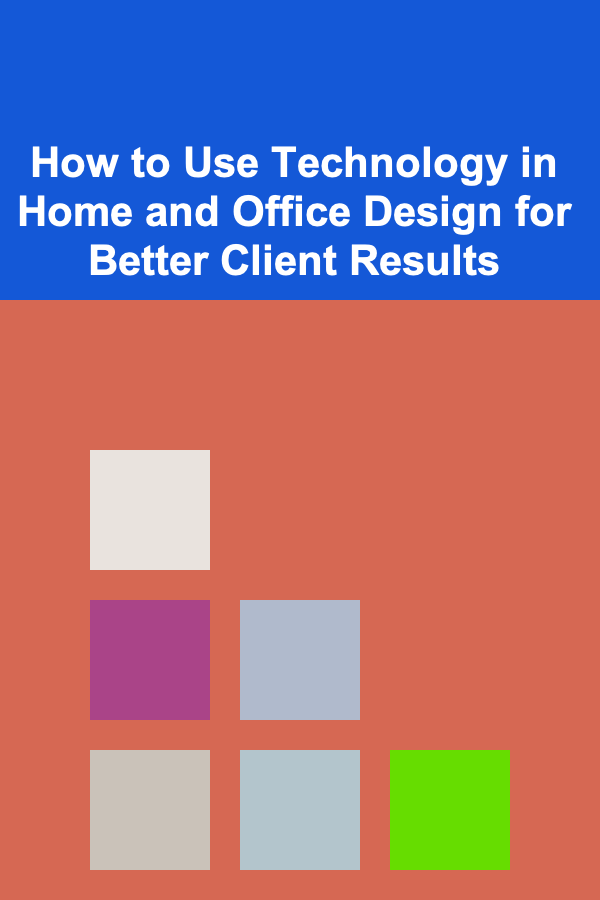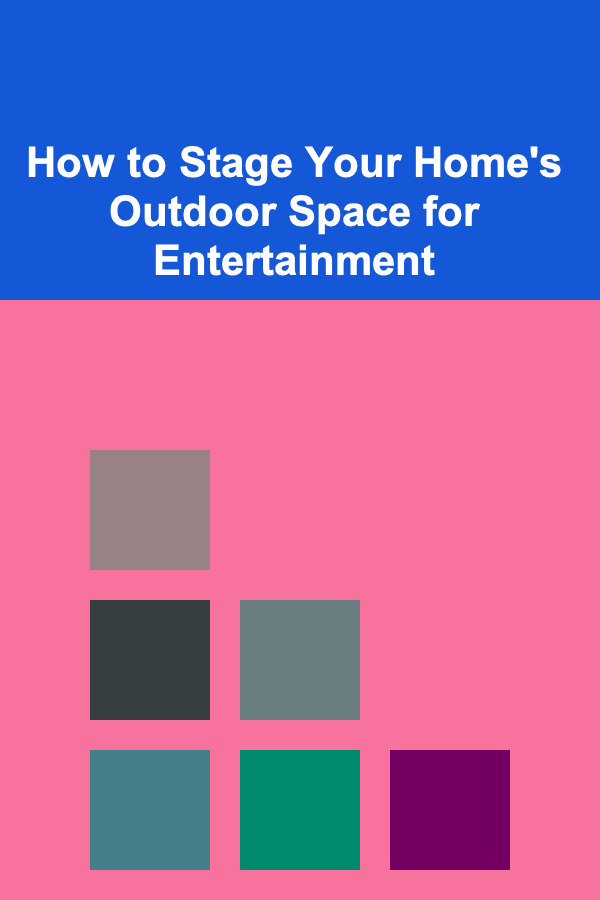
How to Use Technology in Home and Office Design for Better Client Results
ebook include PDF & Audio bundle (Micro Guide)
$12.99$5.99
Limited Time Offer! Order within the next:

In the modern world, technology has revolutionized every sector, including home and office design. Whether you're an interior designer working with clients to transform their spaces or a business owner looking to optimize your office environment, embracing technology can significantly improve both the design process and the results you deliver to your clients. In this guide, we'll explore the various technologies available, how they can be applied in home and office design, and the impact they have on client satisfaction.
The Role of Technology in Home and Office Design
Technology plays a key role in making design processes more efficient, accurate, and visually compelling. From advanced software tools to virtual reality (VR) and 3D printing, technology enables designers to create realistic and innovative designs that cater to the specific needs of their clients. Moreover, technology allows clients to better visualize and interact with their designs before committing to any changes, ensuring that the final result is exactly what they envisioned.
Key Benefits of Using Technology in Design
-
Enhanced Visualization and Communication
One of the main challenges in design is effectively communicating ideas to clients. Traditional methods such as sketches and mood boards can sometimes be limited in conveying the full scope of a design. By using technology, designers can create digital renderings, virtual tours, and even immersive VR experiences that allow clients to walk through a proposed space before it's built.
-
Customization and Personalization
Clients today expect personalized spaces that reflect their unique preferences and needs. Technology facilitates this by offering tools that allow for easy customization. With 3D modeling software and virtual design tools, designers can offer tailored solutions that are both functional and aesthetically pleasing.
-
Improved Efficiency and Accuracy
Technology helps streamline the design process. Software tools automate various tasks such as measurements, calculations, and material specifications, reducing human error. This leads to more precise and accurate designs, ensuring that the final result meets the client's expectations.
-
Cost and Time Savings
By using advanced technology, designers can minimize the chances of costly mistakes or miscommunications. Virtual prototypes and simulations allow for the testing of designs before any physical work begins, which helps to avoid costly changes during the construction or renovation process.
Technological Tools and Innovations for Home and Office Design
1. 3D Modeling and CAD Software
3D modeling and Computer-Aided Design (CAD) software are foundational tools for modern interior designers. These programs allow designers to create three-dimensional models of spaces, providing a realistic representation of the finished product. Some popular CAD tools include:
- AutoCAD: One of the most widely used CAD programs, AutoCAD offers precise design tools that allow for detailed drawings and layouts, ideal for both home and office projects.
- SketchUp: Known for its user-friendly interface, SketchUp is a popular choice for creating 3D models quickly. It is especially useful for designers who want to present their ideas to clients in an easily understandable format.
- Revit: This is an industry-standard software for BIM (Building Information Modeling). Revit allows designers to create accurate, data-rich models, making it an excellent tool for both residential and commercial design.
By using 3D modeling, designers can present clients with lifelike visuals, including details like textures, lighting, and shadows, helping clients make informed decisions.
2. Virtual Reality (VR) and Augmented Reality (AR)
Virtual reality and augmented reality are game-changers in the design world, offering immersive experiences that bring designs to life. These technologies help clients visualize spaces and interact with them before any physical work begins.
- VR Design Simulations: With VR, clients can take a "virtual tour" of their future home or office. They can walk through different areas, interact with furniture layouts, and even adjust design elements to see how they would look in real time. This can be incredibly helpful for large-scale projects, allowing clients to make adjustments before committing to expensive changes.
- AR for Space Planning: Augmented reality can be used to project design elements into the actual space. For example, clients can see how a specific piece of furniture would look in their living room or how a new layout would change the flow of an office space. AR tools, such as those available through smartphone apps like IKEA Place, provide a real-time preview of design choices.
The ability to interact with designs in an immersive way ensures that clients feel more confident in their decisions, leading to higher satisfaction and fewer revisions.
3. Smart Home and Office Technology
As technology becomes increasingly integrated into our everyday lives, smart home and office solutions are gaining popularity. Incorporating these technologies into home and office design not only adds value but also enhances the functionality of the space.
- Smart Lighting and Climate Control: Smart lighting systems like Philips Hue and climate control systems like Nest allow clients to control their environment with ease. These features can be integrated into the design from the outset, creating a seamless and modern atmosphere that suits the needs of the occupants.
- Voice-Activated Assistants: Incorporating voice-activated devices like Amazon Echo or Google Home into the design can create a more connected, hands-free environment, especially in modern offices where multitasking is essential.
- Automated Systems: Automated systems for blinds, curtains, or home security systems can be incorporated into both home and office designs, offering convenience and enhanced security.
By incorporating smart technology, designers can future-proof spaces and offer added functionality, which is an attractive proposition for clients looking for modern, efficient solutions.
4. 3D Printing for Prototyping and Customization
3D printing is revolutionizing the design world by allowing designers to create physical models of their designs before implementation. This is especially useful for custom furniture or architectural elements, as clients can touch and interact with prototypes before making final decisions.
- Furniture Prototyping: Designers can create miniature 3D printed prototypes of furniture or decorative pieces to show clients how the final product will look in their space. This helps in eliminating any misunderstandings about scale, design, or material choices.
- Custom Designs: For unique, bespoke designs, 3D printing allows for the creation of one-of-a-kind pieces that match a client's exact specifications. From intricate lighting fixtures to custom cabinetry, 3D printing provides an unmatched level of customization.
This technology opens up endless possibilities for personalization and ensures that clients get exactly what they envision.
5. Collaboration Tools and Project Management Software
Design projects involve multiple stakeholders, including the designer, client, contractors, and suppliers. Using collaboration tools and project management software streamlines communication and ensures that everyone is on the same page.
- Trello and Asana: These tools help track project timelines, deliverables, and tasks, making it easy to keep everyone in the loop.
- Google Drive or Dropbox: Cloud storage solutions allow designers to share design files, mood boards, and revisions with clients and contractors, ensuring that everyone has access to the most up-to-date information.
- BIM for Collaboration: Building Information Modeling (BIM) software, such as Revit, allows all project stakeholders to work from a shared, 3D model, ensuring that everyone is working with the same set of data.
These tools improve project efficiency, reduce misunderstandings, and help to keep the design process organized.
How Technology Enhances Client Results
By integrating technology into the home and office design process, you can achieve several key outcomes that directly benefit the client:
- Increased Client Satisfaction: Technology gives clients the ability to visualize and interact with their future spaces, reducing the chances of dissatisfaction and rework. VR and AR allow clients to "experience" the space before it's physically built, ensuring their vision is realized.
- Faster Decision-Making: With 3D renderings, smart home technology, and digital prototypes, clients can make decisions more quickly. They can see immediate results, which speeds up approval processes and reduces project timelines.
- More Accurate Designs: Software like CAD and BIM allows designers to create highly accurate representations of spaces, reducing errors and ensuring the final design is as close to the client's vision as possible.
- Cost-Effective Solutions: Using technology helps avoid costly mistakes and design revisions. For example, virtual simulations or AR/VR renderings allow clients to "try" different designs, layouts, and materials without incurring the costs of physical changes.
Conclusion
Technology has fundamentally changed the way home and office design is approached, offering designers powerful tools to enhance creativity, improve communication, and deliver better results for clients. By utilizing 3D modeling, VR/AR, smart home technology, 3D printing, and collaboration software, designers can create more personalized, efficient, and innovative designs. In doing so, they can meet and exceed their clients' expectations, ultimately resulting in more successful projects and higher client satisfaction. Embracing technology is no longer just an option; it's essential for staying competitive in today's rapidly evolving design landscape.

How to Build Customer Trust and Loyalty When Selling Online
Read More
How to Maintain Your Organized Living Room Long-Term
Read More
How to Offer Same-Day Delivery Services for Local Businesses
Read More
How to Organize a Small Pantry for Maximum Storage
Read More
How to Stage Your Home for a Quick Sale in a Slow Market
Read More
How to Stage Your Home's Outdoor Space for Entertainment
Read MoreOther Products

How to Build Customer Trust and Loyalty When Selling Online
Read More
How to Maintain Your Organized Living Room Long-Term
Read More
How to Offer Same-Day Delivery Services for Local Businesses
Read More
How to Organize a Small Pantry for Maximum Storage
Read More
How to Stage Your Home for a Quick Sale in a Slow Market
Read More